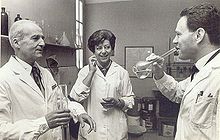Science and technology in Argentina
According to the World Bank, Argentina exports in high-technology are products with high R&D intensity, such as in aerospace, computers, pharmaceuticals, scientific instruments, and electrical machinery.
[2] Benefiting from Latin America's highest literacy rates since shortly after President Domingo Faustino Sarmiento made primary education universally available in the 1860s and 1870s, Argentine researchers and professionals at home and abroad continue to enjoy a high standing in their fields.
Despite its modest budget and numerous setbacks, academics and the sciences in Argentina have enjoyed international respect since the turn of the 1900s, when Dr. Luis Agote devised the first safe and effective means of blood transfusion as well as René Favaloro, who was a pioneer in the improvement of the bypass surgery .
Established in 1991, the CONAE has since launched 8 indigenous built satellites successfully, AMSAT, MuSat, SAC-B, SAC-A, SAC-C, SAC-D/Aquarius, ARSAT I and ARSAT-2.
[9][10] In June 2009, secured an agreement with the European Space Agency on for the installation of a 35-m diameter antenna and other mission support facilities at the Pierre Auger Observatory.
Home to 122 think tanks specializing in public policy and economics issues, Argentina ranks fifth in the number of these institutions worldwide.
[12] In April 2009, Dr. Sandra Díaz, researcher from the Instituto Multidisciplinario de Biologia Vegetal (IMBIV - NU of C), was elected as a foreign associate member to the National Academy of Sciences (U.S.A.) in recognition of her outstanding work on climate change, being the first Hispanic woman to achieve this honor.
[19] Although research intensity has dipped only slightly since 2015, other signs suggest that a lower priority is being accorded to science, technology and innovation; research and infrastructure projects have been cut back or cancelled in the following areas: the extension of satellite networks and radar; the expansion of the nuclear industry; and support for industrial and agricultural R&D through their respective technological institutes.





